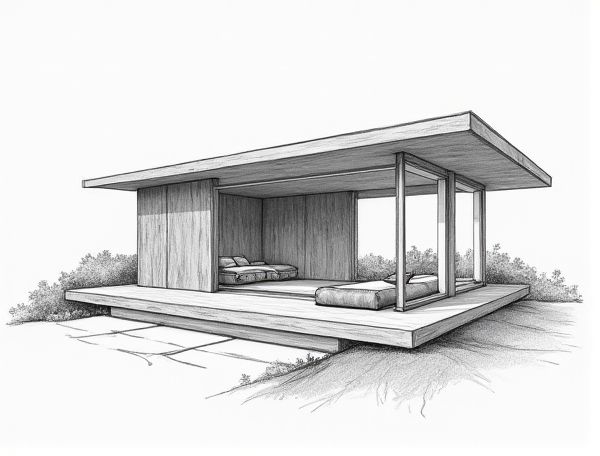
Photo illustration: Minimalist home design with tatami platform rooms
Embrace a minimalist home design by incorporating tatami platform rooms, which blend simplicity with traditional Japanese aesthetics to create serene, multifunctional living spaces. Discover how to transform your home into a calming retreat by reading more in the article.
Introduction to Minimalist Home Design
Minimalist home design emphasizes simplicity, clean lines, and functional spaces to create a calming and clutter-free environment. Your space benefits from neutral color palettes, natural light, and quality materials that enhance the feeling of openness. Embracing minimalist principles improves organization, reduces distractions, and fosters a more peaceful living experience.
The Essence of Tatami Platform Rooms
Tatami platform rooms blend traditional Japanese aesthetics with modern functionality, creating serene spaces that optimize comfort and natural materials like woven straw mats and wood. Your home benefits from these minimalist designs by enhancing spatial harmony and promoting relaxation through simplicity and tactile warmth.
Harmonizing Minimalism and Traditional Japanese Elements
Harmonizing minimalism and traditional Japanese elements in home design creates a serene environment by emphasizing clean lines, natural materials, and uncluttered spaces combined with shoji screens, tatami mats, and wooden accents. This fusion enhances spatial harmony and fosters a tranquil ambiance rooted in wabi-sabi principles, highlighting the beauty of simplicity and imperfection.
Space Optimization with Tatami Platforms
Maximize your living area by integrating tatami platforms, which offer multifunctional seating, sleeping, and storage solutions while maintaining a minimalist aesthetic. These traditional Japanese-inspired designs enhance space efficiency by elevating flooring, allowing hidden compartments that keep clutter out of sight.
Material Choices for a Clean, Serene Aesthetic
Opt for natural materials like light-colored wood, bamboo, and stone to create a clean, serene aesthetic in your home design. Incorporate soft textiles such as linen and cotton to enhance comfort while maintaining minimalism. Your material choices should prioritize durability and sustainability to achieve a calming environment that feels both inviting and timeless.
Functional Storage Solutions in Minimalist Tatami Rooms
In minimalist tatami rooms, functional storage solutions such as built-in wall cabinets, under-floor drawers, and multi-purpose furniture maximize space efficiency while preserving the room's serene aesthetic. Utilizing natural materials like bamboo and light wood enhances both durability and the traditional Japanese design ethos, ensuring clutter-free living environments.
Natural Light and Neutral Color Palettes
Maximizing natural light in your home enhances spaciousness and elevates mood, while neutral color palettes create a harmonious backdrop that complements sunlight, making spaces feel warm and inviting. Incorporate large windows, light-filtering treatments, and shades of beige, gray, and white to optimize both brightness and timeless aesthetic appeal.
Versatile Furniture for Flexible Living Spaces
Versatile furniture enhances flexible living spaces by maximizing functionality and adapting to diverse needs, such as foldable tables, modular sofas, and storage ottomans. This adaptability supports seamless transitions between activities like working, dining, and relaxing without requiring additional room or clutter. Incorporating multi-functional pieces optimizes spatial efficiency and contributes to a stylish, organized home environment.
Biophilic Design: Integrating Nature Indoors
Biophilic design enhances indoor environments by incorporating natural elements such as plants, natural light, and organic materials to improve well-being and productivity. Integrating living walls, large windows, and water features creates a strong connection between indoor spaces and the outdoors. Studies show that biophilic design reduces stress, boosts creativity, and promotes healthier living in residential and commercial settings.
Maintenance Tips for Minimalist Tatami Platforms
To maintain minimalist tatami platforms, regularly clean the surface with a dry, soft cloth to prevent dust accumulation and avoid exposure to direct sunlight that can cause fading or warping. Your tatami platform will stay pristine longer by ensuring proper ventilation in the room to reduce humidity and prevent mold growth.
 homedesy.com
homedesy.com